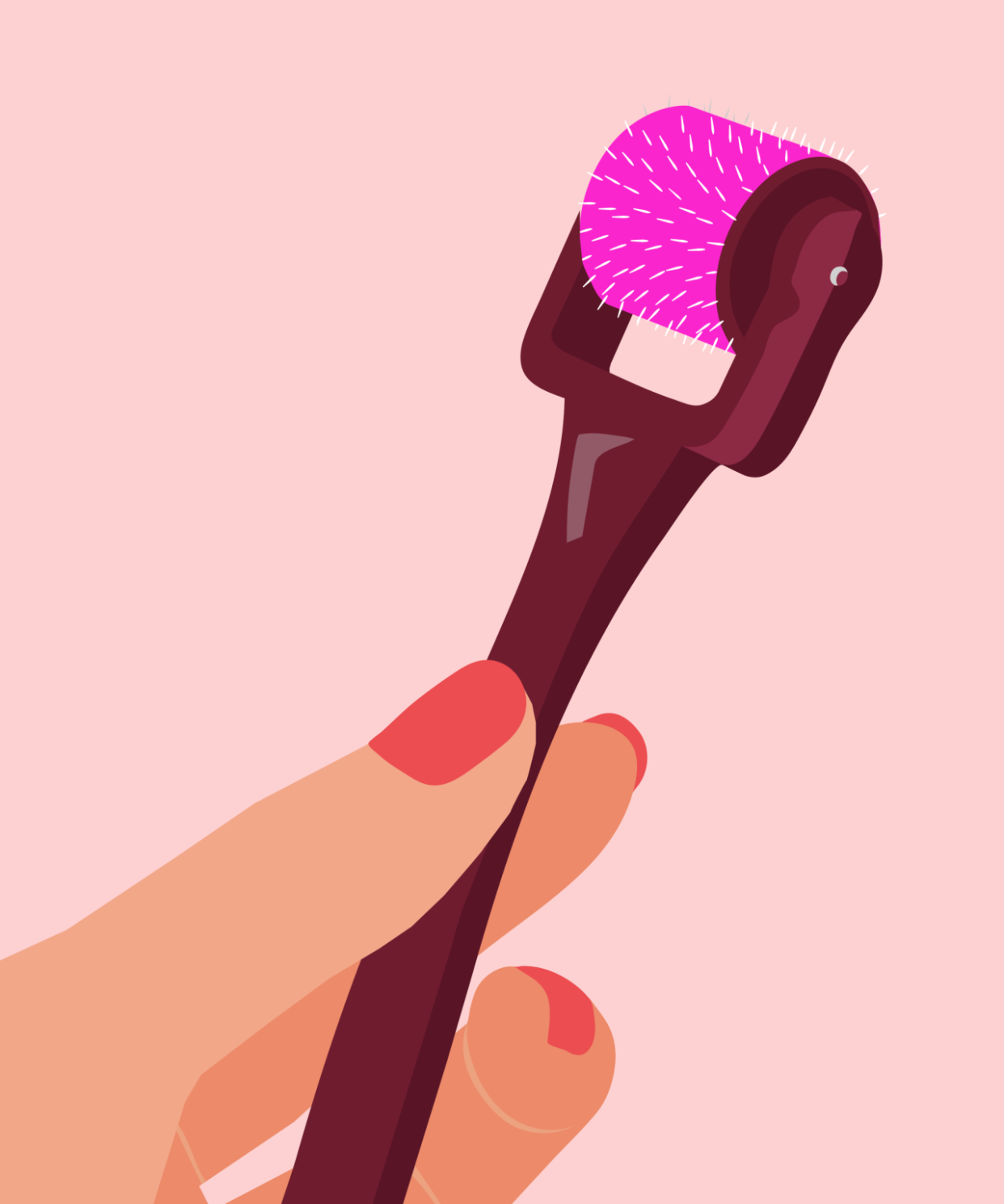Everything You Need To Know About Micro-Needling

Fun fact: The most effective anti-aging treatments rarely come with affordable price tags. The current in-office gold standards —laser treatments, injectables, Thermage — are costly, and even a trip to your aesthetician for something like an acid peel or microdermabrasion can hit your bank account hard. Well, what if there were something that could both stimulate change in the skin and make the products you splurge on work even better? And what if we told you that you could use it at home?
Related: What to Do if You Can’t Get Kylie’s Lip Kit
You may have heard of micro-needling and wondered what all the fuss is about. But unlike many skin-care fads, this one is seemingly lasting the test of time — 15 years and counting — and for good reasons.
Intrigued? We are, too. For guidance on the subject, we consulted two pros — board-certified dermatologist Karyn Grossman, MD, whose patients include Gwyneth Paltrow, Molly Sims, and Linda Evangelista; and Kerry Benjamin, Hollywood aesthetician and creator of her own line of products and tools, Stacked Skincare, which includes one of the only aesthetician-created dermarollers.
Related: Glow International With These Asian Beauty Products
Ahead, everything you need to know to determine whether micro-needling is right for you.

So what, exactly, is micro-needling? Also referred to as dermarolling, this is a treatment that can be done at home, by an aesthetician, or in your dermatologist’s office. It gets its name from the tool used, a dermaroller, which looks a bit like a miniature paint roller, except it’s covered with tiny needles.
Related: Makeup That Won’t Break the Bank
Before you freak out, know that the needles on the at-home devices shouldn’t be painful, since they’re much smaller than those used in a derm’s office. (But more on that later.) Micro-needling has been around since the early 2000s, and works on a similar principle as laser treatments.
Related: Ramp Up the Romance With These Tips
When rolled over the skin, the dermaroller does two things. First, it allows for better penetration of products, thanks to tiny pinpricks that work almost like canals, allowing your products — often serums, since they’re the most viscous — to reach deeper into the skin. Second, it creates micro-injuries, which tell your brain to kick into repair mode. This prompts your body to send collagen to the epidermis, which, as you probably already know, is an important building block of healthy, radiant skin. More collagen, better skin.

You may have read online that dermarolling can magically cure acne scars, fine lines, and brown spots — and even stretch marks and cellulite. There is some truth to this, however, it’s important to understand that the benefits you can realistically expect to achieve depend upon the size of the needles on your roller, Dr. Grossman explains.
Related: How to Grow Out Hair at Any Length
Dermarollers used at home or in an aesthetician’s office are normally between .2 and 1 mm. They help to even skin texture and pigmentation — but don’t expect much change in scars. “[Personally], I don’t think that home micro-needling will get rid of your acne scars or stretch marks,” Dr. Grossman says.
The biggest benefit of at-home rolling is simple: The deeper a product can get into the skin, the more effective it can be. The science on rollers under 1 mm is lacking, Dr. Grossman reminds us, but many aestheticians swear by the efficacy of shorter needles.
Related: Hello, Gorgeous! The Best Beauty Blogs Ever
In fact, Benjamin calls at-home dermarolling one of the “most powerful and effective ways to stop early signs of aging and prevent new fine lines and wrinkles from occurring,” thanks to the uptick in collagen production. She adds it to nearly every facial she gives, and sends her clients home with a roller of their own to use with their favorite serums.
“With the right corrective serums, micro-needling will brighten your skin to create a dewy, youthful glow that you just can’t get from products [alone],” Benjamin says. “If you are going to purchase serums, you should definitely micro-needle at home [to make them more effective].”
Dermarollers used in a dermatologist’s office take results to the next level. Since the needles can be as long as 3mm, you can expect the above results, plus improvement in acne scars, stretch marks, and fine lines. To wit: In a 2009 study, nearly 100% of people studied saw marked improvement in their acne-scarring after several professional treatments using a 1.5-mm roller.
But cellulite? Don’t hold your breath. “I have people ask about [micro-needling] for cellulite, but cellulite is a much deeper issue than you’re going to be able to address [with this tool],” Dr. Grossman says.

Like with all things in life, there are risks. The first thing to know is that you should absolutely, positively, never use this tool on skin that is irritated, inflamed, has active eczema, or — and this is the big one — is broken out.
“Never roll over any active acne — ever!” Benjamin warns. “You can spread bacteria around your face and cause serious health issues. If you have a pimple, be sure to avoid that area completely, and if you have active acne or cystic acne, I don’t recommend micro-needling until your acne is 100% clear.” Rolling over acne also increases your risks of a major infection, Dr. Grossman adds.
There are temporary annoyances, too. “Those with sensitive skin can become red or flushed,” Dr. Grossman notes. “And those who don’t tolerate products well need to be very careful, because you’re causing inflammation in the skin, you’re disrupting the barrier, and you’re increasing penetration of products.”
You may be asking yourself, Wait, I thought I wanted better product penetration? You do, but when active ingredients go deeper into skin, the risk of irritation goes up, which is why Dr. Grossman insists on a patch test of all products you wish to apply after micro-needling. But we’ll explain that later.
And, while this seems like good common sense, never ever share your roller, even if it’s clean — or expect these risks to go way, way up.

The next question you may be asking yourself:How often should I micro-needle? The answer to this isn’t black and white; it has a bit to do with how your skin tolerates it, how long the needles are, and what other skin treatments you’re doing regularly. But in general, our experts recommend somewhere between once weekly and a few times a week.
“I tell patients that if you want to uptick their maintenance at home — and I have patients that like to be highly maintained — I would recommend doing it once a week,” Dr. Grossman says, noting that you can go up to a 1-mm needle size if you limit the treatment to once weekly. “Because again, what do the micro-needles do? At those levels, they make very small injuries in the skin, which certainly allows increased penetration of products. But you also need to be careful, because what goes along with the increased penetration of many products? Increased irritation and inflammation.”
When using a home roller with needles that are on the longer side of the at-home spectrum, Dr. Grossman recommends alternating it with other treatments. You’ll have to pick between peels, dermarolling, and exfoliation — not all three!
Benjamin, on the other hand, prefers a shorter needle, used more frequently, and even done after other treatments, like peels. “I recommend .2-mm rollers for home use. They are super-safe, yet still highly effective,” she says. “Using this size roller, I recommend rolling three to five times a week to get the maximum benefit.”
As a general note, the smaller the needle size, the better your skin can tolerate the treatment. However, Dr. Grossman reminds us again not to overdo it. Stick to one weekly treatment until you know how your skin reacts, and only dermaroll at night, to cut down on environmental (cold, heat, sun) and product (SPF, makeup) stressors that could unintentionally irritate your skin further.

So you made it to slide five, which means you’re still curious, or totally ready to give it a go — let’s pick your roller of choice.
To start slowly (which we recommend), simply heed Benjamin’s advice and pick a roller with .2-mm needles, like the one she uses on her own clients. For something that will penetrate a little deeper, try a .5-mm roller, and eventually you can graduate to a 1-mm size.
When using a roller a few times a week, Benjamin suggests tossing it out and replacing it every month; less frequently used rollers will last longer. “They’re like razors and they dull, so they need to be discarded [regularly] as you could damage your skin with the dull needles,” she says.
It’s also important to note that the .2-mm size feels uncomfortable, but not painful, while the 1-mm is considered painful by some people; .5 mm is somewhere in the middle.
Now that you have your roller picked out, let’s discuss the best way to use it.

Before you begin, wash your hands and face, and dry both using a clean towel. Next, clean your roller with at least 91% isopropyl alcohol (standard drugstore rubbing alcohol) by submerging it in alcohol, then rinsing.
Benjamin tells her clients to divide their faces into sections: the cheeks, chin, and left and right sides of the forehead. (You can do the neck and hands, too, but make sure you wash them first.) Work on one section at a time. The forehead is the most sensitive, so let’s start there to get it out of the way.
Using very light pressure, roll horizontally over your forehead going in even strokes and only going over the same section of skin two to three times at most.
For the rest of our tips, visit Refinery29.
By: Lexy Lesback
Let’s keep in touch! Follow Yahoo Beauty on Facebook, Twitter, Instagram, and Pinterest.

